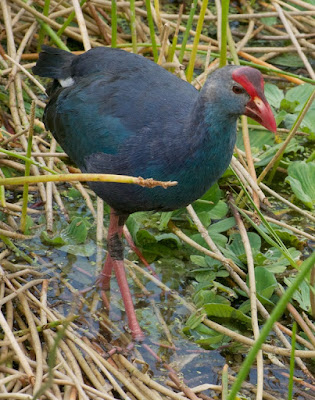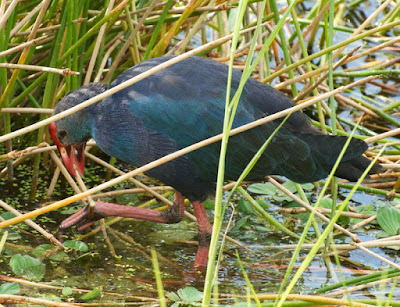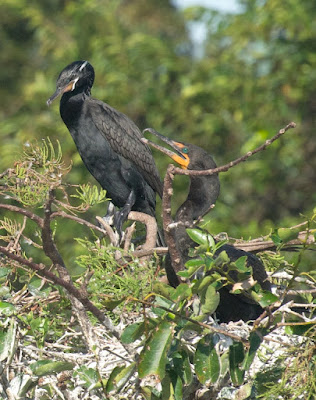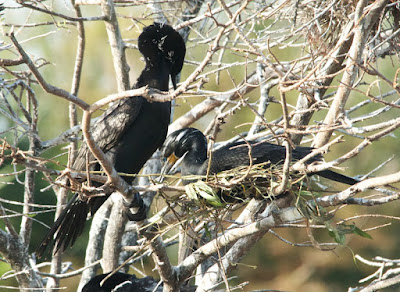When I was a child, I would have had to travel to the Old World to see a Purple Swamphen (Porphyrio porphyrio) - or, if you follow the recent tendency to split that species up, I would have had to go to Asia to see a Grey-headed Swamphen (P. poliocephalus). Thanks to Hurricane Andrew, which destroyed the Miami Zoo's original "Wings of Asia" aviary in 1992, the descendants of escaped Swamphens are increasingly becoming established in South Florida. These are part of a family group of four birds at Green Cay Nature Center, where they seem to be easier to see every year.
Like their smaller native cousin the American Purple Gallinule (Porphyrula martinica), Purple Swamphens are largely vegetarian, and adept at manipulating suitable plant stems with their feet.
Purple (or Grey-headed) Swamphens are only one of a host of exotics, both plant and animal, to have become established in South Florida. They are not even the most obvious ones in the Delray wetlands: at Wakodahatchee Wetlands, immense Green Iguanas (Iguana iguana) drape themselves over the trees - apparently to the consternation of birds like this Anginga (Anhinga anhinga), though iguanas, like the Purple Swamphen, are vegetarians.
Green Iguanas are native to Mexico and tropical America, and like most of the exotic reptiles now swarming through the state they arrived here as by-products of the pet trade.
So did the Oscar (Astronotus ocellatus), a tropical American cichlid fish that now terms in South Florida waters.
This cluster of pink eggs is the product of a species that has done the reverse of the iguana and the Oscar. The Florida Applesnail (Pomacea paludosa) is a native that has become an introduced pest in other parts of the world, including Southeast Asia where its egg clusters are now a common sight.
Not all of the recent arrivals in South Florida are there because we brought them there. Double-crested Cormorant (Phalacrocorax auritus) are long-time residents of Florida, and have been breeding at Wakodahatchee Wetlands for years.
In the last few years, however, another cormorant has begun to join them in the Wakodahatchee rookeries. This is the Neotropic Cormorant (Phalacrocorax olivaceus). 2013 was only the second year birds had been reported breeding there, and the population is obviously growing. Neotropic Cormorants are abundant in the West Indies, Central and South America, but Wakodahatcheee is still, I believe, their only breeding site in Florida.
The two species are not always easy to identify, a problem made greater by the fact that they occasionally hybridize. Here are the two (perhaps an interspecies pair?) side by side, with the Neotropic fortunately in breeding plumage. Notice, as compared to the Double-crested Cormorant in the foreground, the Neotropic's smaller size, smaller bill, paler and differently-shaped patch of bare skin at the base of the bill, and particularly (when present) the white band of feathers around outlining the bare facial skin.
There is little question that these birds are bona fide (or nearly so) Neotropic Cormorants.
The first Neotropic seen here was apparently mated to a Double-crested Cormorant, but now there are enough birds so that at least some of them can find mates of what appear to be their own species.
Fledging young does not appear to be a problem for them either.
The top two photos are unquestionably Double-crested Cormorants. The bottom bird appears to be a Neotropic - again, note the thinner bill and paler bare patch, with a pointed rather than a squared rear margin. However, this bird, an apparent juvenile, lacks the breeding-plumaged Neotropic's fancy feathers, and the bare skin may be a bit too orange. Is this bird a hybrid? It may well be. And what will become of Wakodahatchee's Neotropic Cormorants in future? Will they establish themselves, form an interbreeding swarm with the still far commoner Double-cresteds, or simply disappear whence they came in a few years, as so many other new arrivals have done? As I said when I started, the only certainty is that things will continue to change, both here and in the rest of South Florida.
The two species are not always easy to identify, a problem made greater by the fact that they occasionally hybridize. Here are the two (perhaps an interspecies pair?) side by side, with the Neotropic fortunately in breeding plumage. Notice, as compared to the Double-crested Cormorant in the foreground, the Neotropic's smaller size, smaller bill, paler and differently-shaped patch of bare skin at the base of the bill, and particularly (when present) the white band of feathers around outlining the bare facial skin.
There is little question that these birds are bona fide (or nearly so) Neotropic Cormorants.
The first Neotropic seen here was apparently mated to a Double-crested Cormorant, but now there are enough birds so that at least some of them can find mates of what appear to be their own species.
Fledging young does not appear to be a problem for them either.
The top two photos are unquestionably Double-crested Cormorants. The bottom bird appears to be a Neotropic - again, note the thinner bill and paler bare patch, with a pointed rather than a squared rear margin. However, this bird, an apparent juvenile, lacks the breeding-plumaged Neotropic's fancy feathers, and the bare skin may be a bit too orange. Is this bird a hybrid? It may well be. And what will become of Wakodahatchee's Neotropic Cormorants in future? Will they establish themselves, form an interbreeding swarm with the still far commoner Double-cresteds, or simply disappear whence they came in a few years, as so many other new arrivals have done? As I said when I started, the only certainty is that things will continue to change, both here and in the rest of South Florida.























No comments:
Post a Comment